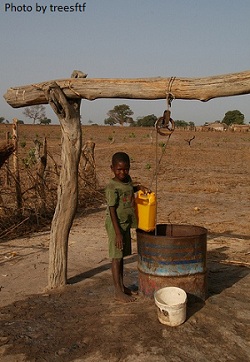Water Source Quality Can Be Preserved by Utilizing Good Source Protection Practices
Water source quality can be preserved by utilizing good water source protection practices.
Note: The content on this page has been adapted from publications of World Health Organization (WHO) and Centre for Affordable Water and Sanitation Technology (CAWST).

What is Water Source Protection?
There are many pollution problems which may threaten drinking water quality, invluding quality at the point of collection, or during transport.
Source quality protection can reduce or eliminate the risk of contamination, resulting in improved water quality and reduced risk of disease.
Source protection should always be practiced as the first step in the multi- barrier approach to safe drinking water.
What Causes Contamination?
The main risk factors for contamination at the water source, collection point and during transport are:
* Poor site selection of the water source
* Poor protection of the water source against pollution (e.g. agricultural runoff contaminated with manure and fertilizers)
* Poor structure design or construction (e.g. lack of a well lining and/or cover, tank sealing, poor pipe connections)
* Deterioration or damage to structures (e.g. cracks can be entry points for contaminants)
* Lack of hygiene and sanitation knowledge and practice in the community
Water Source Quality Protection Practices
The following provides suggestions on several things that can be done to protect different water sources from contamination and improve the quality.
Water Source Quality Protection for All Water Sources and Points of Use (where the water is stored or used):
* Locate latrines downhill and at least 30 meters away from water sources.
* Keep animals away by using fences around the water source
* Maintain separate area for washing clothes and watering animals
* Keep the general environment around the water source and points of use clean and free from excreta and garbage
* Plant trees along creeks and rivers and maintain a well forested area above your water source, to trap contaminants and prevent erosion
* Provide adequate drainage to prevent wastewater from pooling and becoming stagnant, which provides an ideal breeding ground for insect vectors
* Maintain and repair all constructed elements and ensure water source and structures are physically sealed from contaminant inflow (e.g. surface run-off)
* Ensure watershed use is non-polluting

Water Source Quality in Tubewells and Boreholes:
* Line wells and boreholes (provide sanitary seal in the top 2 to 3 meters)
* Keep protected and covered, and construct a parapet wall around open wells
* Use a separately designated, clean rope and bucket, a windlass or a hand pump to pull water out of the well. Store the bucket in its own covered clean platform.
* Build a platform with adequate drainage at the collection point to prevent mud and wastewater from pooling
Springs and Gravity Fed Piped Systems:
* Stabilize springs by building retaining walls and collector boxes with screened intakes
* Dig a surface water diversion channel or ditch above and around the spring development
* Seal the top of the source with a sanitary cap when possible to prevent infiltration of surface run-off
* Plant vegetation around the catchment area but ensure roots will not crack any structures
* Fence off the spring and the catchment area directly above it to prevent contamination from livestock or people
* For gravity fed systems, protect and maintain collection and storage tanks, lay piping 50cm below ground or deeper were possible
Rivers and Lakes:
* Mark separate zones for washing and watering animals downstream and away from water collection areas
Rainwater Harvesting:
* Cut back any trees or vegetation overhanging the catchment surface
* Collect and store rainwater in covered tanks which are periodically cleaned
* Clean catchment surface, gutters and screens prior to first rain of the season
* Divert and do not consume water from the first rain
* Use a first-flush system to divert first few millimeters of each rainfall event as it contains dust accumulated on the roof or catchment area
Water Collection and Transport
It is vital that people collect water in clean containers and keep them covered while transporting water from the source to the point of use, to prevent water contamination after collection. Containers used to transport water should be dedicated to that purpose and never used for other activities.
Return to "Water Treatment" from "Water Source Quality"
Return "Home"









